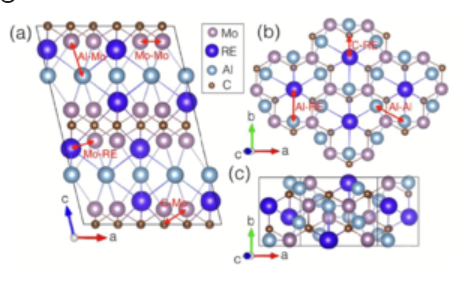
-
- to
"The recent discovery of quaternary MAX phases with chemical in-plane order allowed the addition of nontraditional MAX phase elements, such as rare-earth elements. In the present study, first-principles calculations are performed to investigate the electronic structure, elastic and hardness response, and bonding strengths of the novel RE−i−MAX phases with the formula (Mo2/3RE1/3)2AlC. The Voigt-Reuss-Hill bulk, shear, and Young's moduli are compared along the series of RE = Nd, Sm, Gd, Tb, Dy, Ho, Er, Tm, and Lu, and the global trend is found to depend on the unit cell volume. Nanoindentation experiments on Ho-based single crystals result in moduli that are within 10% of predicted values and a hardness of ∼10 GPa. The computation of the projected density of states, projected crystal orbital Hamilton population, and integrated projected crystal orbital Hamilton population, reveals that the bonding of Mo and RE atoms with the Al atoms are weaker than those with the C atoms, suggesting the exfoliation of RE−i−MAX into two-dimensional RE−i-MXenes to be feasible. Such a possibility to form two-dimensional crystals is further confirmed by the computation of the exfoliation energies, which demonstrates the process to be easier as the RE atomic mass decreases."


